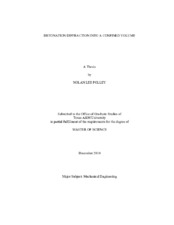Detonation Diffraction into a Confined Volume
Abstract
Detonation diffraction has been, and remains, an active area of research. However, detonation diffraction into a confined volume, and specifically the transformation of a planar detonation into a cylindrical detonation, is an area which has received little attention. Experimental work needs to be conducted on detonation diffraction into a confined volume to better understand how the interaction of the diffracted shock wave with a confining wall impacts the detonation diffraction process. Therefore, a facility was constructed to study this problem, and experiments were conducted to determine under what conditions a planar detonation could be successfully transformed into a cylindrical detonation. Four different fuel-oxidizer mixtures, C₂H₂+ 2.5 O₂, C₂H₂+ 4 O₂, C₂H₄+ 3 O₂ and H₂+ 0.5 O₂, were tested in this study using a combination of pressure transducers and soot foil records as diagnostics. Three different regimes of successful transmission; spontaneous re-ignition, continuous reflected re-initiation, and discontinuous reflected re-initiation, were identified. The detonation cell size and the distance from the tube exit to the confining wall, or gap size, were determined to be the most important parameters in the transmission process and a linear correlation for determining whether or not transmission will be successful for a given set of initial conditions was developed for gap sizes between 10 and 35 mm. For gap sizes smaller than 10 mm or gap size larger than 35 mm the linear correlation does not apply. Finally, the results of this study are compared to results on detonation diffraction into a confined volume available in the literature and explanations for any disagreements are given. This study showed that when compared to transmission of a detonation into an unconfined volume, the transmission of a detonation into a confined volume, for the majority of gap sizes, is possible for a wider range of conditions. However, for extremely small gap sizes, when compared to transmission into an unconfined volume, the range of conditions for which successful transmission is possible into a confined volume is actually narrower.
Citation
Polley, Nolan Lee (2010). Detonation Diffraction into a Confined Volume. Master's thesis, Texas A&M University. Available electronically from https : / /hdl .handle .net /1969 .1 /ETD -TAMU -2010 -12 -8714.


